Wang Xueye: "Strontium Isotope Archaeology: Principles, Methods, and Applications" & Lecture Newsletter
On November 3, 2023, the third "Archaeological Science Forum" hosted by the Center for Archaeological Science, Sichuan University was held in the conference room on the first floor of the Institute of Tibetan Studies of Wangjiang Campus, Sichuan University. Associate Research Fellow Wang Xueye gave a lecture on "Strontium Isotope Archaeology: Principles, Methods, and Applications", which was presided over by Professor Lu Hongliang, Director of the Center for Archaeological Science, Sichuan University.
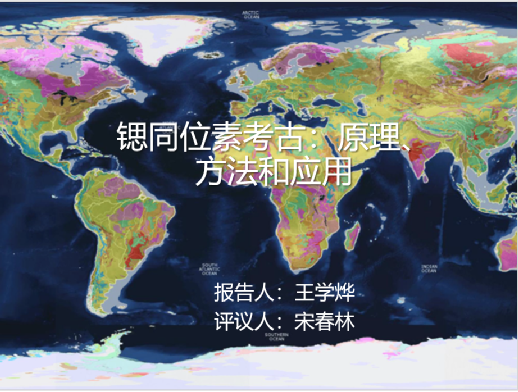
In recent years, isotope technology has been widely used in archaeological research, especially in human bone research. Stable isotopes such as carbon (C), nitrogen (N), oxygen (O), and sulfur (S) have obvious isotope fractionation effects in nature, which can reveal dietary structures or indicate climate. Isotopes such as strontium (Sr) and lead (Pb) do not have obvious fractionation effects in nature and are mostly used for tracing studies. In particular, strontium isotopes have become one of the key elements for tracing the migration of ancient humans and animals, and are widely used in forensic medicine, ecology, geology, hydrology, food and other fields.
Strontium has four stable isotopes in nature: 84Sr, 86Sr, 87Sr, and 88Sr. Among them, 87Sr is a radiogenic isotope, which is formed by 尾-decay of 87Rb. According to the decay principle, the 87Sr/86Sr ratio of a rock or mineral depends on the initial Rb/Sr ratio and age of the rock or mineral. On a macro level, strontium isotope ratios differ under different geological backgrounds.
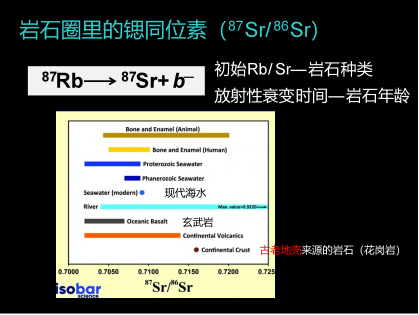
Strontium that enters the water and biosphere through weathering of bedrock and is then utilized by organisms is called bioavailable strontium. In addition, the weathering rate of different minerals and the input of external strontium such as atmospheric deposition will also affect biological strontium, making the bioavailable 87Sr/86Sr value different from the 87Sr/86Sr value in rocks. Research on tracing the migration behavior of people or animals usually refers to the index characteristics of bioavailable strontium. Calcium is the main component of teeth and bones and is often expressed as hydroxyapatite. When strontium enters the organism through the food chain, there is little fractionation. Because strontium has similar chemical properties to calcium, strontium will replace part of the calcium and remain in the crystal lattice of teeth and bones when teeth are formed. Therefore, the 87Sr/86Sr composition of human or animal teeth and bones in a certain area should be consistent with the 87Sr/86Sr background value of the area. The outermost enamel component of teeth is stable and hardly changes after it is formed in early childhood, making it an ideal material for tracing studies. If the strontium isotope of an individual's tooth enamel is different from the local strontium isotope background value, it is generally believed that the environment in which he/she grew up in childhood is inconsistent with the environment before death, and it can be judged that the individual is likely to have migrated from another place.
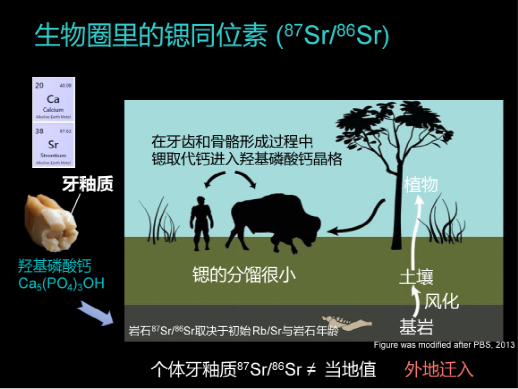
Strontium isotopes have obvious advantages over other isotopes. The main advantages are: First, the mass number is large and the fractionation effect is small; second, 87Sr is derived from the decay of 87Rb, with a half-life of 4.9脳1010 years, and strontium isotopes remain stable within the time scale of archaeological research; third, strontium isotopes are sensitive to reactions, and if there are foreign individuals, obvious changes can be reflected in the measured values; fourth, strontium is stably preserved in the enamel of ancient people and is rarely affected by later diagenesis. When using strontium isotopes for tracing research and exploring archaeological questions such as whether humans and animals have migrated and the distance of migration, it is necessary to establish an accurate strontium isotope map in order to improve the accuracy of tracing.
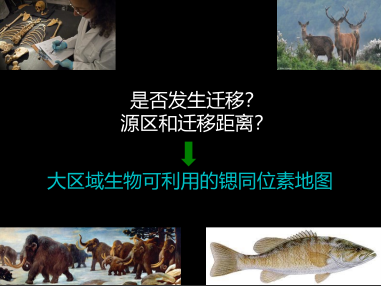
Constructing an accurate strontium isotope map requires collecting a large number of environmental or biological samples as basic values, usually based on plants and some small animals with weak migration abilities. The spatial changes of strontium isotopes in large areas presented in the study are mainly completed by data modeling methods. The more common method is the geostatistical spatial interpolation method based on the assumption that the closer the distance, the more similar the strontium isotopes are. The strontium isotope values of areas without detected samples are inferred through known sample points. At present, France has used this method to establish strontium isotope maps for multiple countries, which is the most representative. Researchers sampled plants and soils from different geological blocks in France, and the results showed that the strontium isotopes of plant and soil leachates at the same location showed a strong correlation (R2=0.99), constructing a coupled strontium isotope map of plants and soil leachates. In addition, the Bayesian AverageR model established by the Max Planck Institute for the Science of Human History in Germany is also very representative. The speaker once used this model to establish the first strontium isotope map of the Yellow River Basin in China. These two methods are mainly based on data modeling and do not fully consider factors such as geological background. In recent years, researchers from the British Geological Survey have fully considered geological factors, divided samples according to lithology, and calculated strontium isotope maps for each lithological environment, with significant results.
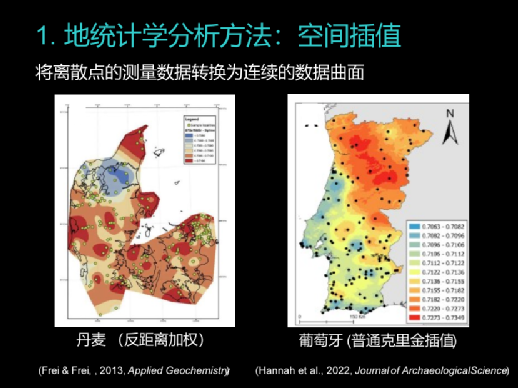
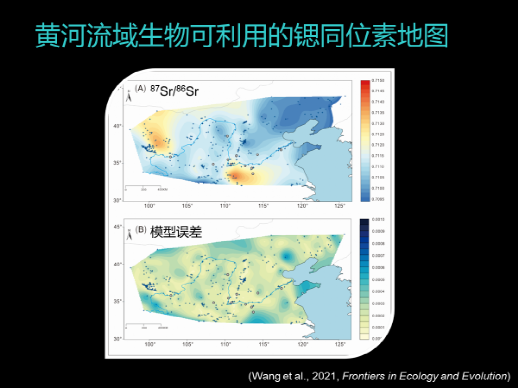
In recent years, machine learning methods (random forest regression algorithm) have been gradually applied to isotope mapping. This method integrates multiple variables such as geology, climate, soil, environment, and human pollution into the modeling framework to obtain a more accurate strontium isotope map. A typical case is that the Bataille team established the world's first bioavailable strontium isotope map based on this method and integrating existing strontium isotope data. The limitation is that the vast majority of data comes from Europe and the United States, while the strontium isotope baseline data in China, Africa and other places are seriously lacking, resulting in obvious deficiencies in the strontium isotope simulation results when studying these two places.
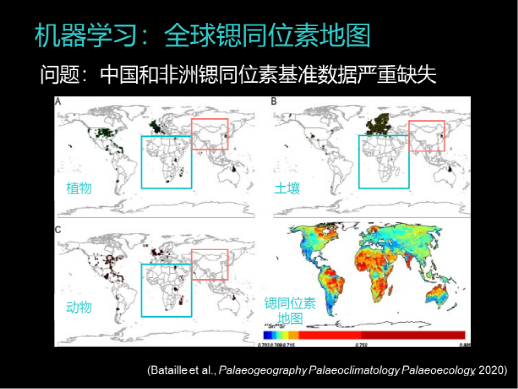
Recently, Wang Xueye established the first bioavailable strontium isotope map of China based on 1935 environmental samples and biological samples using the ordinary Kriging interpolation method. He integrated existing literature data and supplemented the data of archaeological sites in the Yellow River Basin, Northeast and Northwest China. The strontium isotope map can provide reliable data support for tracing and source tracing in archaeology, hydrology, paleoecology, forensic medicine, and food science. He also collaborated with multiple international teams to establish the African strontium isotope map, which is extremely critical for exploring the migration of ancient humans and animals and the origin of humans, using an improved version of the geographically weighted random forest regression algorithm.
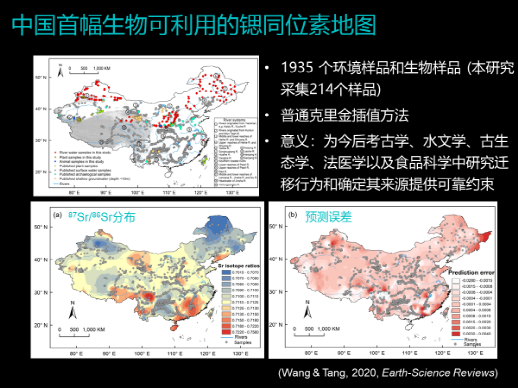
It should be pointed out that strontium isotopes have a problem of multiple solutions in source tracing research. For example, in areas with similar geological backgrounds, strontium isotope values are usually similar, making it difficult to distinguish population migrations between these areas. To solve this problem, multiple isotope methods are usually used to further constrain the source. For example, oxygen isotopes indicate climate indicators such as temperature and precipitation. It can be determined whether an individual is from another place by comparing the difference between the oxygen isotope of the tooth enamel of the detected individual, the oxygen isotope of the water source ingested, and the place of residence. Carbon and nitrogen isotopes can reflect the diet structure, and the combination of considerations can further constrain the source.
Traditional strontium isotope testing is mainly based on the dissolution method, using thermal ionization mass spectrometry or multi-collector inductively coupled plasma mass spectrometry for determination. This method has high precision, but the pretreatment requires collecting at least 10-20mg of samples, which results in large losses, and the spatial resolution is low. In recent years, LA-MC-ICP-MS has been applied to enamel analysis to make up for this defect. This method requires fewer samples and is widely used in strontium isotope analysis of precious samples. At the same time, this method has a high spatial resolution and can provide accurate isotopic information on the seasonal migration of humans or animals. Compared with the traditional dissolution method, LA-MC-ICP-MS is susceptible to isobaric interference, especially the interference of 40Ca31P16O, and the analysis accuracy is poor.
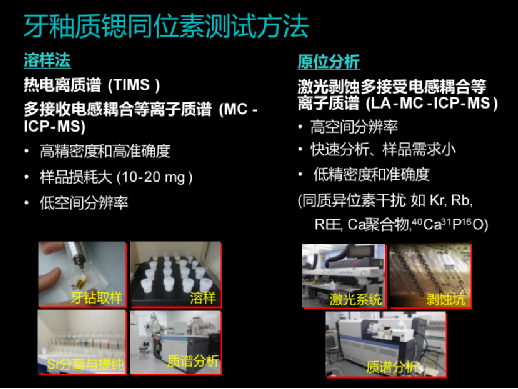
The speaker introduced the archaeological application of strontium isotopes with a number of vivid examples. Such as the habitat selection of Australopithecus, the early human exchange network, the impact of ancient social structure and organization, and the domestication of animals and plants on ancient social lifestyles, especially the impact of population migration on the spread of ancient technology, archaeological tracing of the trans-Atlantic slave trade, simulation of the seasonal activity range of red deer in Paleolithic sites, and reconstruction of the life history of extinct animals.
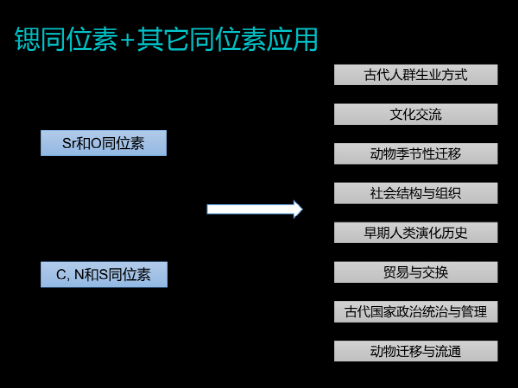
Song Chunlin, Associate Research Fellow of the College of Water Resources and Hydropower of Sichuan University, commented that strontium isotopes have extremely strong advantages in tracing, are less affected by the environment or experimental operations, and can solve many archaeological problems when combined with other isotope research, which is worthy of attention. The teachers and students attending the meeting had in-depth discussions on the issues involved in the report, especially on the reliability of the strontium isotope map and solving practical archaeological application problems.
Wang Xueye is currently a specially appointed Associate Research Fellow at the Center for Archaeological Science, Sichuan University, mainly engaged in isotope archaeological research. He graduated from the Institute of Geology and Geophysics, Chinese Academy of Sciences with a Ph.D. in Quaternary Geology, and then went to the Department of Anthropology, University of California, Santa Cruz for postdoctoral research. His previous work was to construct the first strontium isotope maps of China and Africa through geostatistical analysis methods and machine learning algorithms, respectively, and to explore population migration on the ancient Silk Road and the source tracing of the trans-Atlantic slave trade in the 15th-19th centuries in combination with multi-isotope evidence of human bones. Currently, he has published 7 papers as the first author in journals such as Earth-Science Reviews, Journal of Archaeological Science, Archaeological and Anthropological Sciences, and participated in multiple national-level fund projects at home and abroad.
